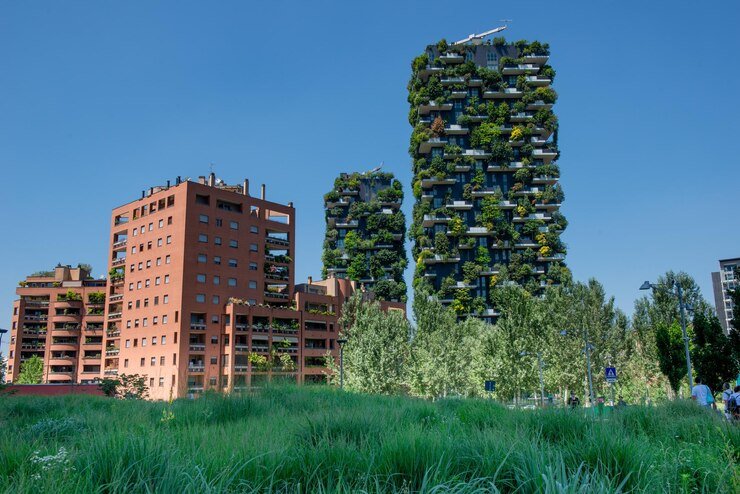Climate-responsive homes: building for a sustainable future is not just a trend but a need of the hour. These homes are designed to work with nature, not against it, making them energy-efficient, eco-friendly, and comfortable for everyday living. By carefully considering the local climate, these homes reduce energy use while offering a cozy and modern lifestyle.
Imagine a home that stays cool in the summer without blasting air conditioners or keeps warm in the winter with minimal heating. Climate-responsive homes do exactly that! They use simple yet smart techniques like natural ventilation, proper shading, and insulation to save energy and protect the environment. Let’s explore how these homes can shape a greener future
What Are Climate-Responsive Homes and Why Are They Important
Climate-responsive homes are buildings designed to match the local weather, which helps to lower energy costs and make the environment better. These homes are created to use natural elements like sunlight, wind, and temperature changes. By doing so, they are not just comfortable but also energy-efficient. This means that instead of relying on heating or cooling systems all year, these homes stay at a pleasant temperature.
The main idea behind these homes is to reduce the need for extra energy. By using the sun for warmth or the wind for fresh air, climate-responsive homes make life more comfortable while lowering energy bills. As climate change affects the planet, building homes that use nature’s energy is more important than ever.
Why are these homes so important
- Lower energy use: They save money on energy bills by using nature’s energy.
- Less pollution: By reducing energy use, these homes help to lower carbon emissions.
- More comfort: Homes naturally stay at good temperatures without using extra power.
Top Features of Climate-Responsive Homes: Building for a Sustainable Future

There are several key features that make a climate-responsive home different from a regular house. One of the most important features is passive design. This means designing the home in a way that uses natural light, wind, and the surroundings to keep it comfortable. Instead of adding extra heating or cooling systems, these homes are designed to work with the environment.
Another feature is energy-efficient materials. These materials help keep the house warm in winter and cool in summer. For example, thick walls can trap heat, while big windows can let in sunlight. Using these materials reduces the need for air conditioning or heaters.
Some homes also use rainwater harvesting systems. This allows them to collect rainwater for use in gardening or even inside the home, reducing the need for water from outside sources. By using what nature provides, climate-responsive homes help protect the planet.
How Passive Design Can Save Energy and Improve Comfort
Passive design is a clever way to make homes more energy-efficient and comfortable. By carefully planning where windows and doors go, the home can use sunlight and natural air to stay comfortable. In the daytime, large windows can let in sunlight to heat the home. At night, windows can be closed to trap warmth inside.
Passive design also helps to keep the home cool in the summer. With proper shading, the sun’s heat can be blocked from entering the house. This keeps the inside cooler without needing air conditioning. Even simple changes like using the right colors for roofs and walls can make a big difference in how much heat a house absorbs or reflects.
Benefits of Passive Design
- More energy savings: You don’t need to use heaters or air conditioners much.
- Comfortable living: The home stays at a good temperature all year long.
- Eco-friendly: Less energy use means fewer carbon emissions.
Natural Ventilation: The Key to Eco-Friendly Living

Natural ventilation is another important feature of climate-responsive homes. Instead of relying on fans or air conditioning, natural ventilation uses the wind and well-placed openings to move fresh air through the house. When windows are placed in the right spots, air can flow freely, helping to cool the home without energy-hungry systems.
This design helps reduce energy consumption and supports a healthier home environment. With natural ventilation, you can reduce moisture build-up, prevent mold, and enjoy fresh air inside. It also reduces the need for artificial cooling, which uses a lot of energy.
How Does Natural Ventilation Help
- Improves air quality: Fresh air circulates through the house, making it healthier to live in.
- Saves energy: No need for electric fans or air conditioners.
- Reduces indoor moisture: Helps keep the home dry and mold-free.
Conclusion
In conclusion, climate-responsive homes: building for a sustainable future is all about making smart choices that help the environment and save energy. By using natural resources like sunlight, wind, and rainwater, these homes can stay comfortable without wasting energy. They not only lower your utility bills but also reduce the negative impact on the planet, helping to fight climate change.
These homes are a step forward in creating a more sustainable world. With better materials, smart designs, and eco-friendly systems, climate-responsive homes are shaping the future of construction. By building homes that work with nature, we can live more comfortably and reduce our carbon footprint.
FAQs
Q: What are climate-responsive homes
A: Climate-responsive homes are designed to use natural resources like sunlight and wind to stay comfortable and save energy.
Q: How do climate-responsive homes save energy
A: They use passive design, natural ventilation, and smart materials to reduce the need for heating, cooling, and electricity.
Q: Can I build a climate-responsive home on any land
A: Yes, but the design may change depending on the local climate, such as orientation and shading to fit the environment.
Q: Are climate-responsive homes more expensive to build
A: They might cost a little more upfront, but they save money in the long run by reducing energy bills.

